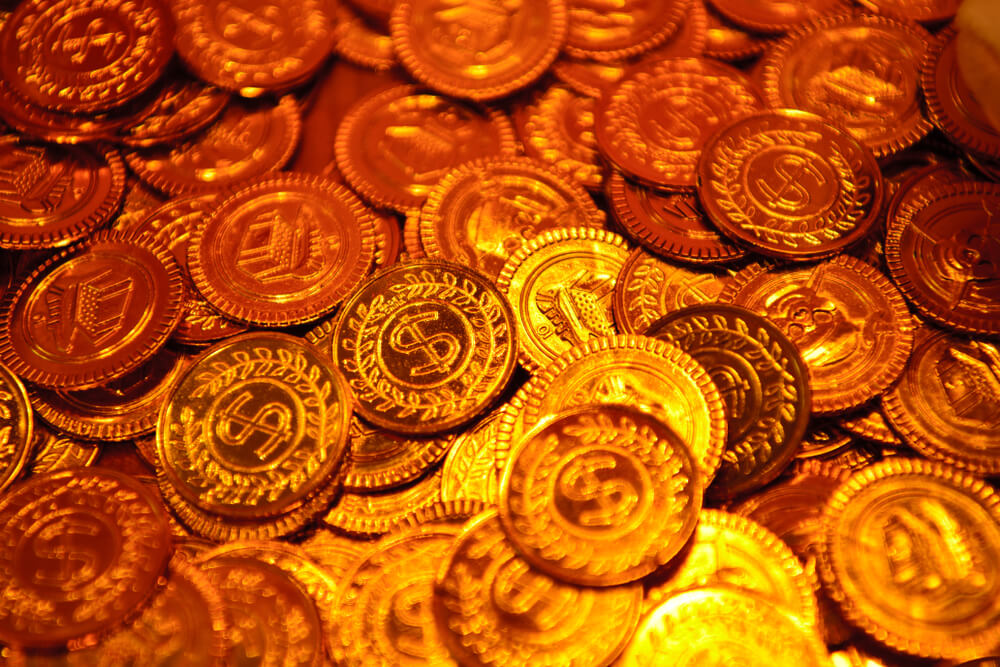
Gold Coins: A Complete Overview
Gold has been around for centuries. Gold coins may seem like a relatively new phenomenon. But that is not the case. Maybe not as old as gold itself, gold coins have graced the planet with their presence for centuries too. They were first used as money somewhere around 700 BC. Gold has been valuable to humans even before it was conceived as money. But the creation of gold coins provided a sense of organization to the value attached to the precious metal. Gold’s rarity, beauty, density, malleability, or the ease with which it could be softened, measured, and formed, made it an easy pick as a trading medium.

It would not be presumptuous to state gold gave birth to the idea of money. Gold and later silver coins standardized transactions, replacing barter arrangements and making trade easier during the ancient eras. As more gold was found, gold coins proliferated too. Because gold coins have been around for such a long time, the “rare” gold coin concept exists. The same cannot be said of gold bars.
Table of Contents
To help you know better, this article intends to delve into the intriguing realm of gold coins, investigating their history, kinds, investment potential, etc. The sub-topics we’ll particularly pay attention to include:
- A brief overview of gold coins
- The different categories of gold bullion coins
- Popular gold bullion coins on the market
- Investing in bullion coins and more
Read more: The Best 1 oz Gold Coin to Buy
Read on for an engaging and informative deep dive into gold bullion coins and their timeless allure.
Gold Coins: A Brief Intro to Their History, Design, and More

Gold coins in their earliest phases weren’t industrially made. They were essentially stamped lumps of electrum (a mix of gold and silver). The Persians and Lydians were the pioneers of gold coinage, helping establish monetary systems worldwide. The 7th-century Lydian civilization was set in current-day Turkey. They minted the first set of standardized gold coins. Persia’s Achaemenid Empire solidified the gold coinage concept. They expanded upon the Lydians’ gold coin minting innovation, minting a range of gold coins accepted across their vast empire for trade.
From the Romans to the Byzantines, gold coins symbolized financial strength, underpinning empires and promoting world trade. The coins minted in the ancient Greek cities of Corinth and Athens depicted heroes, gods, and mythological creatures, reflecting the Greek civilization’s artistic and cultural accomplishments. During Roman Empire’s peak, the aureus rose as a premier gold coin. After their fall, the Byzantine Empire emerged to carry gold coinage’s legacy.
During the Middle Ages, Islamic Caliphates, like the Umayyads and Abbasids, introduced the gold dinar. These gold coins came with inscribed Quran verses, serving as money and representing the Islamic faith. During the Age of Exploration and Renaissance, the English guineas, Spanish doubloons, and other gold coins became vital economic influences and expansion tools. Fast-forward to the 19th century, the gold standard’s adoption further cemented the positioning of gold coins in global trade.
Currently, gold coins are sought-after for their investment potential. Since the value of gold coins is intrinsic and not superficial (or based on the face value), gold bullion coins serve as a veritable and dependable way to preserve wealth. Investors consider the precious metal coin a safeguard against inflation, economic uncertainty, and fiat money fluctuations. Also, the current set of gold coins is more aesthetically pleasing, besides being historically significant.
The reputable mints producing the coins gilded with intricate designs bear testimony to human craftsmanship and ingenuity. The coins reflect various periods, themes, and cultures, attracting collectors and encouraging them to build a collection. The coin’s aesthetics and the stories intertwined with each coin help forge connections with times you had no idea of. Gold coins serve as your guide to history or urge you to learn more about the coin’s historical significance.
Types of Gold Coins
Gold coins are not a monolith. They come in several different kinds, serving different purposes and preferences. Knowing the distinct types and their key attributes is vital before investing in or collecting them. The following are the four broad categories of gold coins.
Bullion Coins
A bullion gold coin is a coin known for its purity and standardization. State or private entities usually produce gold bullion coins in different weights to cater to various budgets and investment objectives. As mentioned above, the focus is purely on weight and purity. As a result, a gold bullion coin is generally devoid of numismatic or artistic aspects. Bullion coins are usually circulating currency and have face values, usually lower than the coin’s actual worth or melt value.
Numismatic Coins
Numismatic coins are worth more than their melt value or the gold they contain. Generally made by private mints or the state, these coins are rare, historically significant, and have a certain aesthetic appeal. Gold coin enthusiasts or investors with a collector’s mindset get drawn to these bullion coins for the historical context, craftsmanship, and limited supply. The demand is usually higher than the supply, resulting in these coins trading higher than gold’s spot price.
A century-old numismatic coin with a $1 face value can trade for several thousand dollars if there’s demand for it. But there’s also the possibility of losing money on these coins. So, know what coins you’re looking at. Don’t shop for numismatic coins alone, as that could be a loss-making venture. Do your research and get familiar with the rare coins space before splurging. Generally, people benefiting from their numismatic coin purchases have held the coin for at least a decade.
Commemorative Coins
As the name indicates, commemorative coins are gold coins minted to celebrate or honor certain events, individuals, or anniversaries. They are sought by investors keen on collector coins and like history-preserving memorabilia. These coins are usually minted in limited numbers and only once every few years. They boast intricate designs and could have special finishes or coloring.
Commemorative coins usually sell for a premium, and the money generated could be used for specific causes. For example, the United States Mint’s commemorative coins include a “surcharge” that goes toward projects and organizations benefiting the community. The US Mint started its commemorative coin initiative in 1982. Since then, the program has generated over $500 million in surcharges, helping maintain national monuments, build new museums, support different Olympic programs, preserve historical sites, etc.
Proof Coins
Proof coins are gold coins struck with excellent detail and sharpness. They have a mirror-like finish with frosted design elements, which collectors highly seek. The basic design is identical to the coins belonging to the same coin series. These coins do not sport a completely fresh design. The term “proof” denotes the coin’s finish. Blanks used to mint these coins are hand-polished, cleaned, and specially treated to ensure strikes of the highest quality. A proof coin is usually sold in sets presented in protective cases or capsules.
Proof coins are issued in limited numbers, which boosts their collector appeal. Bullion, commemorative, and numismatic coins can be made in standard and proof avatars. However, the direct opposite of a proof gold coin is not a non-proof coin but a reverse-proof one. Reverse proofs have surface finishes that are directly contrasting to their proof versions. The production technique of reverse proof coins is similar to the proof versions, but the finishes are applied in reverse.
Popular Gold Coins
Gold coins are available in different types, purity levels, designs, themes, sizes, etc. But only a few stand out from the crowd. The following are the best gold bullion coins to buy or invest in.
See our list of Gold Coins here
American Gold Eagle
The American Gold Eagle coin is a 22-karat (91.7% pure gold) coin—the other metals being copper (5.33%) and silver (3%). Made by the United States Mint and one of the most popular American gold coins, the Gold Eagle comes in different sizes, from 1/10 oz to up to 1 oz. The coin’s design is based on the Saint-Gaudens Double Eagle coins, designed by the eponymous Augustus Saint Gaudens. The American Gold Eagles feature Lady Liberty on the front and two eagles on the reverse. The coin was first issued in 1986, thanks to the advent of the Gold Bullion Coin Act of 1985, and has had quite a few design changes over the years.
Learn more about the American Eagle gold coin
Canadian Gold Maple Leaf
The Canadian Gold Maple Leaf is a 24-karat (99.99% fine gold) bullion coin, one of the purest gold coins. Canada's official gold bullion coin comes in sizes ranging from 1 oz to as small as 1/20 oz. It showcases the country’s cultural symbol, the maple leaf, on its rear. The coin’s obverse features the right profile shot of Queen Elizabeth II. The coin has been produced since 1979 at the Royal Canadian Mint and has paved the path for several pure gold coins that were made after. The Canadian government guarantees the quality and purity of Canadian Maple Leafs.
Click here to learn more about Canadian Maple Leafs
South African Gold Krugerrand
Introduced in 1967, the Krugerrand is the modern world’s first gold bullion coin. The name “Krugerrand” is a compound term, which takes “Kruger” from Paul Kruger, former South African president, and “rand” is a unit of the country’s currency. The South African Mint and the Rand Refinery make the 22-karat coin. During the 1960s and 1970s, South Africa had the world’s biggest gold reserves, and the Krugerrand is a product of that excess gold. Although being legal tender, the Krugerrand had no face value. It’s assumed to be equivalent to a rand, which the coin is worth more than.
Click here to learn more about the Krugerrand Gold
Austrian Gold Philharmonic
The Austrian Vienna Philharmonic gold coin was first minted in 1989 and has captivated bullion coin collectors and investors alike ever since. Produced by the Austrian Mint, the iconic gold coin is named after the Vienna Philharmonic Orchestra. The 99.99% pure gold coin features the grand pipe organ from the Musikverein concert hall on its front and a set of musical instruments the famed orchestra uses on its rear. The coin’s musical theme mainly attracts investors and collectors with musical backgrounds or those interested in music. The coin is available in multiple sizes, from 1 troy ounce to as small as 1/25 troy ounces. The coin’s denominated value is 100 euros, which was 2,000 Austrian schillings before 2002. The Vienna Philharmonic gold coin is one of the few to be minted since its inception without a break period.
Learn more about the Austrian Vienna Philharmonic gold coin
British Gold Britannia
Made by the United Kingdom’s Royal Mint, the Gold Britannia coin symbolizes British craftsmanship and heritage. Introduced in 1987, the 24-karat gold coin pays tribute to the country’s rich history. The coin’s obverse showcases an engraved image of Queen Elizabeth II. The reverse depicts Britannia, a personified version of Great Britain, holding a shield and trident. Note that the coin’s pure gold content was 91.7% before 2013. The coin’s reverse design has been subjected to alterations too.
Investing in Gold Coins
Adding gold to any investment portfolio is an excellent way to add diversity and lower the risks of owning paper assets. Gold coins and gold bars are usually preferred for investment. The one major advantage coins have over bars is history and rarity. Bullion bars are generic, both in looks and what they bring otherwise. On the other hand, gold coins can be more than just items of pure gold. If you can lap up a rare coin, it will sell for a much bigger premium whenever you liquidate it.
Not to mention, all the other benefits linked to investing in physical gold apply to bullion coins (inflation hedge, wealth preservation, liquidity, etc.). For those who care, gold coins are highly portable and provide a sense of possession that stocks or bonds do not afford. Although real estate offers the feeling of ownership, too, it’s not readily accessible or doesn’t offer direct control the way gold coins do.
Note that not all gold coins enjoy the same global acceptance as those mentioned above. Therefore, pick your gold coin after having done proper research. The aforementioned gold coins aren’t rare, so getting your hands on them shouldn’t be an issue. But if you want to consider other options, look at the American Buffalo gold coins. We’ve discussed American Gold Buffalo coins in detail here. A few other ideal gold investment coins are discussed in this article, including the Australian Kangaroo and Chinese Gold Panda gold coins.
Also, check out coins from other countries, such as Chinese and South Korean gold coins. South Korean gold is usually high in purity. When shopping, look to buy coins made by the government or a state-recognized mint. The most prestigious mint in South Korea is the South Korean Mint, also called KOMSCO (Korea Minting and Security Printing Corporation). You can buy gold coins directly from the mint here. The Chinese Gold Panda Coins made by the China Mint are pretty prominent. You can buy them straight from the Chinese Mint website too.
Always buy gold coins from reputable, established dealers. Ensure they specialize in selling gold coins and are certified to do so. If there’s a reputable dealer you know or have done business with in the past with no complaints, stick to them. Don’t deal with new sellers (online or offline) you have no idea about. Look to auction places if wanting access to rare and unique pieces. But get to know the auction house and its review catalogs thoroughly beforehand. And have a budget to prevent overbidding.
Preferably, deal with sellers part of the Numismatic Guaranty Corporation (NGC) and Professional Coin Grading Service (PCGS). The PCGS and NGC grading is optional but essential if looking at less popular gold bullion coins, such as this Korean Gold Chiwoo Cheonwang gold coin. The grading ensures the coins are built to the quality and purity claimed, are in excellent physical condition, etc. Mint or well-preserved coins get a higher grade, which is more desirable among investors and collectors and commands higher prices.
Storing and Preserving Gold Coins
Like every other valuable piece, gold coins must be stored in a safe and secure environment. Safe deposit boxes, home safes, professional vaulting services, etc., are good options. Understand your insurance and accessibility options for the stored coins. Since a gold coin’s physical condition is paramount, handle the bullion coins carefully. Wear lint-free, clean gloves whenever you touch them to avoid micro-scratching their surfaces.
Even when stowed away, ensure the coins are placed in coin sleeves or capsules to prevent tarnishing and scratching. Avoid exposure to excessive moisture, heat, or chemicals, which could lead to the gold coins distorting, warping, etc. Reduce the need to take the coins out of their storage boxes every time you want to have a look. Use display cases, framed presentations, or coin albums. These display or storage options will also safeguard the coins from environmental stress.
Read more: How to Store Gold Properly
Conclusion
Gold coins preserve wealth, embody craftsmanship, and serve as money. They have fascinated our ancestors and continue to enthrall gold buyers and collectors alike to date. From Roman to modern times, gold coins stood for financial might. The coins, however, are now used less as a currency and more as an investment asset and precious collectible. Not to mention, there’s no dearth of variety and other options with gold coins.
If you want to invest in gold coins, know the type, purity, and overall popularity. Although gold coins are highly liquid, some could be easier to sell. The aforementioned gold coins are among the most liquid gold bullion coins. If you fancy rare coins, go ahead but do your due diligence and approach them with a long-term mindset because they can be a challenging sell. Not to mention, they are also not IRA-eligible. You can invest in bullion and rare coins simultaneously. But ensure the bullion types make up the majority for liquidity reasons.
Whether you invest in gold bullion coins for safeguarding wealth or board a journey of coin collecting to appreciate their history and aesthetics, the gold coin world is captivating and worth exploring.
FAQs
Are numismatic coins allowed in a gold IRA?
No, numismatic or rare coins are not eligible for inclusion in a gold or precious metals IRA (individual retirement account) as they do not conform to IRS guidelines for the kind of precious metals allowed in an IRA. The IRS does not like numismatic coins in an IRA because they are mainly valued for their historicity, rarity, and collectible appeal, not their precious metal content. Intrinsic value is straightforward to quantify, but rarity and historical significance are not easy to assign a number to, making it challenging to ascertain their worth, which in turn would make it tricky to determine the IRA’s value.
Which is the largest gold coin ever?
The 1 Tonne Australian Kangaroo Gold Coin is the largest gold coin ever minted. Made by the Perth Mint in 2011, the 99.99% pure gold coin is 12 cm thick and measures 80 cm diametrically. The Guinness World Records awarded the behemoth the world’s “largest coin” title in 2012. The coin, with a face value of one million Australian dollars, is a major draw for people visiting the Perth Mint and is considered one of the most astonishing accomplishments of the historic Australian mint.
What are uncirculated gold coins? Are they the same as proof coins?
An uncirculated gold coin, as the name indicates, is a gold coin that has never been in circulation. And because it is not circulating coinage, it’s mostly found in pristine condition. They are minted using the same techniques as standard coins. They lack proof coin-like frosted design aspects or mirrored background fields. There are no boosted aesthetics or distinct visual contrasts. Collectors may also seek uncirculated coins but for different reasons than proof coins.


